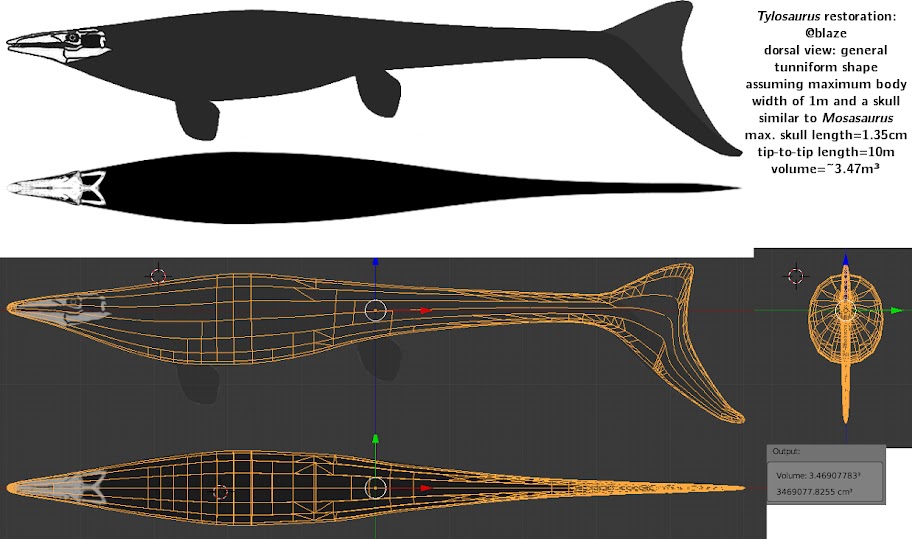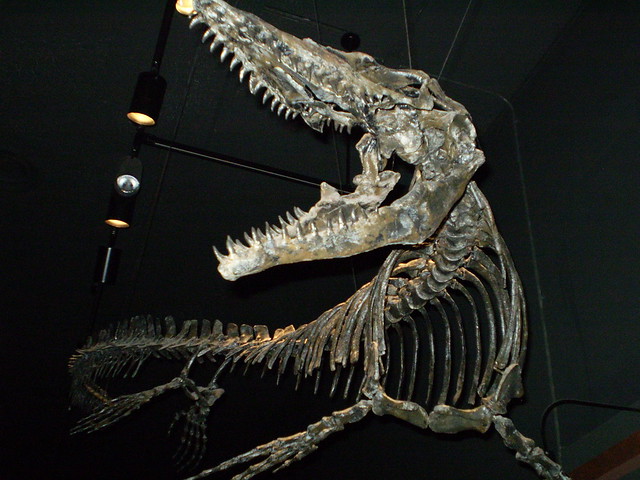Deathadder
Junior Member
  aspiring paleontologist. theropod enthusiast.
aspiring paleontologist. theropod enthusiast.
Posts: 240 
|
Post by Deathadder on Jun 27, 2015 16:46:26 GMT 5
So was I right? Or close to it?
|
|
Deleted
Deleted Member
Posts: 0
|
Post by Deleted on Jun 27, 2015 20:23:46 GMT 5
So was I right? Or close to it? The lower bounds of the range you guessed should just be about right or at least pretty close. |
|
|
|
Post by Grey on Jun 27, 2015 20:53:15 GMT 5
Tylosaurines are understood to be quite light weight but there is the persistent claim that mosasaurines were more robustly built. Prognathodon is definitely more solidly built than tylosaurines. Plus there is the depiction of mosasaurs now more deeper chested, more thunna-like in shape. So I wonder. blaze I agree that Grigoriev estimate is largely debattable but I guess that Everhart considers it possible given the uncertainties about the total life size of the Russian material. Maybe 17 m can be seen as an upper bound for this specimen. Also, what do you think about the huge partial dentary I posted ? |
|
blaze
Paleo-artist   
Posts: 766
|
Post by blaze on Jun 27, 2015 22:19:56 GMT 5
From where does the claim that Progathodon was more solidly built than tylosaurines come from? it is defintely true for the skull but for the rest of the body?
I really don't see how the material can have enough wiggle room to suggest 17m, the lower jaws even if in pieces are mostly complete, a priori we have to assume Mosasaurus had a considerably smaller head relative to its body when compared to Hainosaurus and Tylosaurus in order to suggest 17m for it.
If that partial dentary is really 90cm with only 10 teeth then is huge but some of the tooth positions look suspiciously far apart as if there is a missing tooth socket that was not reconstructed there, possibly increasing tooth positions up to 13 in which case it is about the same size as the Russian material.
|
|
|
|
Post by elosha11 on Jun 28, 2015 2:28:28 GMT 5
Wow some great finds here. Without reading through the whole thread, what would be the rough weight estimate for a 17 meter mosasaur? They were relatively elongated and flexible animals. 30-40 tons perhaps? I would think they'd be a bit lighter than comparably long whales or mega-toothed sharks. 30-40 tonnes is way over the top for any known mosasaur, even for a ~17-meter one. More like roughly around ~15-16 tonnes assuming that a ~14.2-meter Tylosaurus had roughly the same volume as a Giganotosaurus. To get one at ~30-40 tonnes you'll need to get it to lengths roughly around ~21.2-23.3 meters or so. Thanks. I wouldn't have thought they would be that light at 17 meters. How are you deriving that figure? Of course, there is evidence that ginsu sharks may have preyed on mosasaurs of similar or even longer length than the shark. Although a 6-7 meter mosasaur would be quite formidable, I'd guess it might only weigh 1-2 tons in comparison to a probable 2.5-3 ton ginsu shark of 6 meters. Where do pliosaurs generally fall in the weight category. I would assume they were much heavier than mosasaurs (at least at the mosasaur weights you mention) but they still seem less robust to me than megatoothed sharks, orcas (pound for pound, probably the most robust oceanic macro-predator), or certain whales like the bowhead or sperm whale. Pliosaurs seem more crocodilian in their overall mass, and I'd venture that a typical mosasaur species is even more eel/snake like, trading weight for increased flexibility. |
|
|
|
Post by coherentsheaf on Jun 28, 2015 3:31:24 GMT 5
At a given length, pliosaurs are about as heavy as white sharks.
|
|
|
|
Post by theropod on Jun 28, 2015 4:32:56 GMT 5
^Yes, crocodilians don't even come close to their bulk.
|
|
|
|
Post by Grey on Jun 28, 2015 4:39:30 GMT 5
At a given length, pliosaurs are about as heavy as white sharks. Weren't you suspecting McHenry's mass estimates to be a tad too high ? |
|
|
|
Post by coherentsheaf on Jun 28, 2015 4:44:06 GMT 5
At a given length, pliosaurs are about as heavy as white sharks. Weren't you suspecting McHenry's mass estimates to be a tad too high ? Hm, they probably are- I just gave the "McHenry" response without thinking too much about it. The torso lengths in particular are low, someone would have to reevaluate the whole thing some time. However, my GDI of the Rhomleosaurus probably still gives a plausible lower bound. From this you get that they cannot be much lighter than sharks. |
|
|
|
Post by theropod on Jun 28, 2015 16:17:05 GMT 5
Since the version of Blender I got when updating my OS seems to finally sport a reliable volume estimation package for the purpose of 3D-printing, I thought I’d give this a go:  At a straight-line length of 10m this animal would have a mass very close to 3.5t (since its density can be assumed to be similar to water), so yes, roughly similar to allosaurs that have axial lengths in this region, but with a lower volume and higher density. That means at 15m, it would be about 11.7t and so forth. The largest mosasaur I’m aware of is still the giant quadrate illustrated by Lingham-Soliar. If legit, with a skull length of 1.95m and similar proportions to those in Blaze’s reconstruction, the owner would be about 14.4m long and 10.5t in weight. I’ve ignored the flippers because I was too lazy to model them accurately (and frankly neither good enough a 3D-modeler myself) and their impact doesn’t seem to be that significant. In real life, they would add a few tens of kilograms (maybe 100+kg in a very large specimen, but not much more than that). My dorsal view is relatively conservative too, so this should be considered a cautious estimate, but I think it could come close to the real mass. In any case, based on this it would appear that there have been a few significant under- and overestimates in the past, and unless some mosasaurs were way more robust than this, I don’t think any reached the 20t-mark. However it was more or less a guess, so any suggestions regarding body width or the general dorsal-view morphology would be very welcome. EDIT: I’ve attached the model and other relevant files. EDIT-II: Slight update of image and a correction pertaining to my background image, model ended up being scaled 7cm too small, (9.93m instead of 10m, now amended). Attachments:mosamass.tar.bz2 (864.71 KB)
|
|
Deleted
Deleted Member
Posts: 0
|
Post by Deleted on Jun 28, 2015 22:29:37 GMT 5
Since the version of Blender I got when updating my OS seems to finally sport a reliable volume estimation package for the purpose of 3D-printing, I thought I’d give this a go:  At a straight-line length of 10m this animal would have a mass very close to 3.4t (since its density can be assumed to be similar to water), so yes, roughly similar to allosaurs that have axial lengths in this region, but with a lower volume and higher density. That means at 15m, it would be about 11.5t and so forth. The largest mosasaur I’m aware of is still the giant quadrate illustrated by Lingham-Soliar. If legit, with a skull length close to 2m and similar proportions to those in Blaze’s reconstruction, the owner would be about 14.8m long and 11t in weight. I’ve ignored the flippers because I was too lazy to model them accurately (and frankly neither good enough a 3D-modeler myself) and their impact doesn’t seem to be that significant. In real life, they would add a few tens of kilograms (maybe 100+kg in a very large specimen, but not much more than that). My dorsal view is relatively conservative too, so this should be considered a cautious estimate, but I think it could come close to the real mass. In any case, based on this it would appear that there have been a few significant under- and overestimates in the past, and unless some mosasaurs were way more robust than this, I don’t think any reached the 20t-mark. However it was more or less a guess, so any suggestions regarding body width or the general dorsal-view morphology would be very welcome. EDIT: I’ve attached the model and other relevant files. Man I wish I could actually use blender, then I can figure out how large my skeletals(the ones I can actually get a good guess of body width from) actually end up in mass and volume. Your assumed mosasaur width isn't really off the mark by much, if at all.   |
|
|
|
Post by theropod on Jun 28, 2015 22:41:53 GMT 5
^Thanks dude, looks like it’s pretty good (a torso slightly deeper than wide is what I was aiming for).
And you can, it’s not that complicated (well, modeling and texturizing stuff so that it’s realistic and/or animating it is, but making a rough model sufficient for volume estimation of a relatively simple shape, such as a mosasaur, really isn’t), surely nothing you couldn’t learn in an hour or two. Now that the volume-addon works properly, it’s definitely worth it.
Also I’d highly suggest you give it a try, it would be great if you’d supply volumetric weight estimates with your skeletals.
|
|
|
|
Post by creature386 on Jun 29, 2015 0:02:30 GMT 5
Blender and mosasaurs…
Remember your old Tylosaurus, theropod?
Nice work BTW.
|
|
|
|
Post by theropod on Jun 29, 2015 0:11:55 GMT 5
Ugh! Yes, my very first tries to model something. Terrible results, obviously (it looked terrible and was also terribly inaccurate, based on modern data on the morphology of these animals). And back then I just couldn’t get the armatures or even the shape keys to work, so the animation was equally terrible. Later I did get those to work (there are a few test videos on youtube that prove it, from the time when I still made youtube-videos), but I’ve come to realize that the amount of expertise necessary to do something really good with that is just too much.
|
|
|
|
Post by coherentsheaf on Jun 30, 2015 21:38:25 GMT 5
theropodMaybe try to compare the body width with the body width of (sub-)carangiform sharks. They are probably the hydrodynamic equivalent and there are selective pressures for conformity in place.
|
|